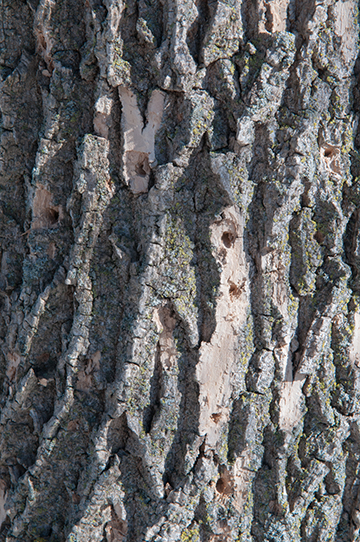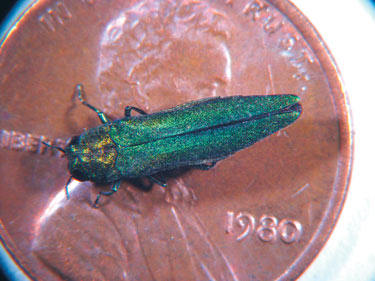It’s sad but true:
As I drive around the north suburbs, I am noticing many roadside trees with a spray-painted mark or a ribbon around the trunk. As an arborist, I know that these are ash trees marked for removal because of the emerald ash borer (EAB). The emerald ash borer is beginning to hit our area hard, and many municipalities are trying to stay one step ahead of this ash-tree-killing insect by proactively removing these doomed ashes.
 If you have an ash tree on your property you should be monitoring for this pest, as it is only a matter of time before the borer finds your tree. In winter, the easiest way to identify if your tree already has EAB is to look for woodpecker damage. From a distance, woodpecker damage looks like lighter colored patches on the trunk, as you can see in this picture. Woodpeckers make these marks as they feed on the tasty (to them) borers that are just under the bark. Once you start seeing evidence of EAB activity, your tree will most likely suffer severe dieback within three years. There is an insecticide treatment that can save your tree, but treatments need to begin before your tree is infested.
If you have an ash tree on your property you should be monitoring for this pest, as it is only a matter of time before the borer finds your tree. In winter, the easiest way to identify if your tree already has EAB is to look for woodpecker damage. From a distance, woodpecker damage looks like lighter colored patches on the trunk, as you can see in this picture. Woodpeckers make these marks as they feed on the tasty (to them) borers that are just under the bark. Once you start seeing evidence of EAB activity, your tree will most likely suffer severe dieback within three years. There is an insecticide treatment that can save your tree, but treatments need to begin before your tree is infested.
For more information on EAB and treatments, please contact the Garden’s Plant Information Service or check out these sources:
- The Garden’s EAB web page
- This short list of ash tree alternatives
- Trees for 2050, a longer list of recommended plantings due to climate change and for urban planning.
- Nightmare on Ash Street, our virtual field trip with Google Connected Classrooms
©2013 Chicago Botanic Garden and my.chicagobotanic.org


You are partially correct in your statement about treating trees with insecticide. Best results with soil injected or basal treatment products have the best success prior to infestation. However, trunk injection with Tree-Age is effective up to 30% canopy loss.
True, but in general it best and recommended to start insecticide treatments prior to symptoms and dieback; even with TREE-age insecticide. Start treatments when EAB is found in your area within 15 miles.
The TREE-age chemical distributor, Arborjet, indicates that treatments may be made at up to 40% dieback, but that’s a lot of damage. Arborjet recommends beginning treatment when EAB is detected in your area, but when trees still appear healthy for best outcomes.